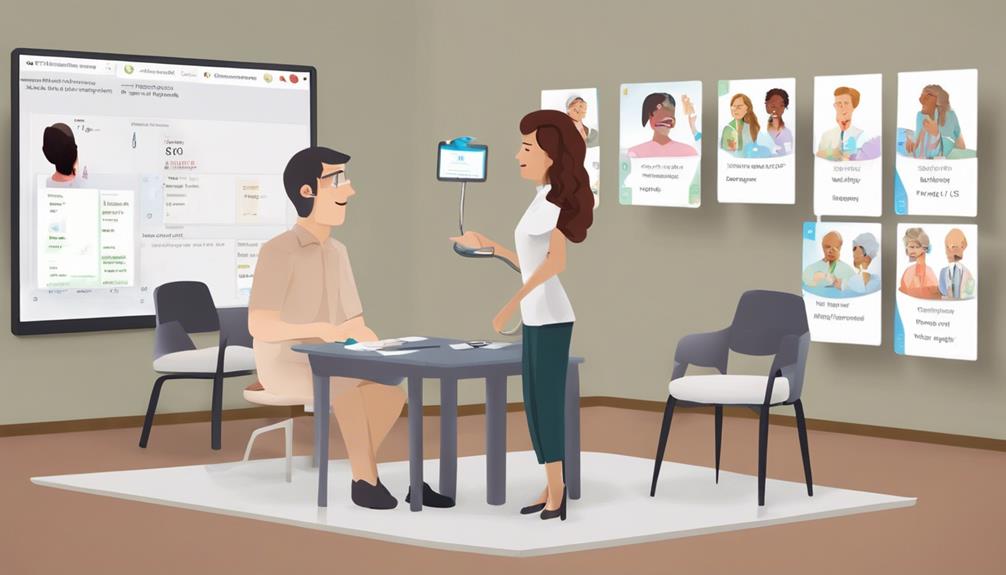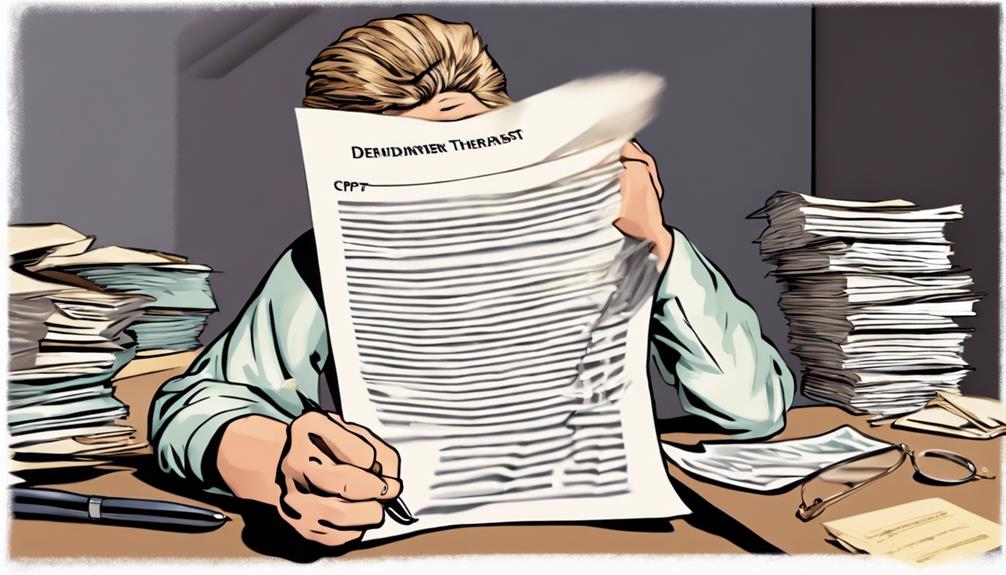Therapies and Interventions
5 Pragmatic Goals for Speech Therapy Success
Succeed in speech therapy with 5 pragmatic goals that transform communication skills and boost progress – find out how!

As speech therapists, we often ponder the effectiveness of our goal-setting strategies in aiding clients' progress. But what if there were pragmatic goals that could significantly impact speech therapy success? These goals not only enhance communication skills but also foster a sense of achievement and growth.
Let's explore how setting specific objectives, incorporating real-life situations, monitoring progress, encouraging practice, and celebrating successes can pave the way for remarkable advancements in speech therapy outcomes.
Key Takeaways
- Define measurable objectives for enhancing pragmatic language skills
- Incorporate real-life situations for practical skill application
- Monitor progress and adjust goals based on individual needs
- Encourage consistent practice through structured sessions and feedback
Setting Specific Communication Objectives
When setting specific communication objectives in speech therapy, we focus on defining clear and measurable goals to enhance pragmatic language skills. These goals are designed to improve social communication by targeting areas such as initiating conversations, interpreting nonverbal cues, and maintaining dialogues effectively.
By setting measurable benchmarks, we can track progress and evaluate the development of pragmatic language skills over time. It's essential to tailor these goals to individual needs and abilities to ensure personalized and effective outcomes in achieving successful social interactions.
Specificity in goal-setting is crucial as it helps in honing in on the essential pragmatic language skills needed and facilitates meaningful improvements in communication abilities. Through appropriate goal-setting in speech therapy, we aim to help individuals develop the necessary skills to engage in social interactions, take appropriate turns in conversations, and use language effectively to convey their thoughts and emotions.
Our ultimate goal is to empower individuals to communicate confidently and effectively in various social settings.
Incorporating Real-Life Situations

To enhance pragmatic language skills effectively, we integrate real-life situations into our speech therapy sessions for practical application and skill generalization. Using real-life scenarios helps individuals transfer learned skills to authentic social interactions effectively. Real-life situations provide meaningful contexts for practicing social communication skills and problem-solving abilities. By incorporating real-life examples, speech therapy clients can develop skills that are relevant and applicable to their daily lives. Engaging with real-life situations fosters a deeper understanding of social cues, norms, and expectations for improved social interactions.
- Enhances practical application and skill generalization
- Helps transfer learned skills to authentic social interactions
- Provides meaningful contexts for practicing social communication skills and problem-solving abilities
- Fosters a deeper understanding of social cues, norms, and expectations
Monitoring Progress and Adjusting Goals
Regularly tracking and analyzing data on goal progress is essential to assess effectiveness and make necessary adjustments in our speech therapy sessions. By monitoring progress in verbal and nonverbal communication, social skills, and pragmatic language goals, we can ensure that our interventions are tailored to individual needs. Utilizing observation notes, checklists, and standardized assessments allows us to document advancements and challenges in achieving goals for speech therapy accurately. Collaboration with parents, teachers, and professionals provides valuable feedback to inform decisions on goal modifications, ensuring that our approach remains relevant and effective.
Adjusting goals based on client feedback, success rates, and ongoing assessment results is crucial to maintaining conversation and maximizing progress in pragmatic language skills. Modifications based on skill development and evolving communication abilities help us meet the social pragmatic goals of each individual. By staying responsive to the data and insights gathered, we can adapt our strategies to best support our clients on their journey towards improved communication and social interaction.
Encouraging Consistent Practice

Encouraging consistent practice is essential for individuals to effectively develop and enhance pragmatic language skills in speech therapy. To maintain focus on this crucial aspect, we encourage the following strategies:
- Use Structured Practice Sessions: By incorporating structured activities tailored to specific social scenarios, individuals can practice and refine their pragmatic skills in a targeted manner.
- Asking for Feedback: Encouraging individuals to ask for feedback from their speech therapists or peers can provide valuable insights into areas for improvement and growth.
- Body Language Awareness: Emphasizing the importance of body language, including maintaining eye contact and using appropriate facial expressions, can enhance overall social language proficiency.
- Setting Practice Goals: Setting achievable practice goals helps individuals track their progress, stay motivated, and work towards mastering various aspects of pragmatic communication.
Celebrating Milestones and Successes
Transitioning from encouraging consistent practice, we now focus on celebrating milestones and successes in speech therapy to boost motivation and reinforce progress. Acknowledging achievements, no matter how small, is crucial in building confidence and encouraging continued effort. By recognizing progress and setting goals, we create a positive learning environment that fosters improvement over time.
In speech therapy, celebrating milestones involves not only the individual but also their communication partners. Practicing appropriate greetings and farewells, using words, body language, and tone of voice effectively, and identifying signs of understanding are all milestones worth celebrating. Encouraging appropriate comments and responses in social situations, as well as taking conversational turns smoothly, are significant successes in communication development.
Tracking these successes and milestones not only provides a sense of accomplishment but also reinforces the importance of consistent effort. Celebrating progress in speech therapy isn't just about reaching the end goal but also about recognizing the journey and growth along the way.
Frequently Asked Questions
What Are Pragmatic Function Goals in Speech Therapy?
Pragmatic function goals in speech therapy focus on improving social communication skills.
These goals target the ability to use language appropriately in social contexts, enhancing conversational skills, understanding nonverbal cues, and social interactions.
They help individuals navigate social norms and develop meaningful relationships.
Our tailored speech therapy interventions address specific communication challenges, aiding in the achievement of these pragmatic function goals for improved social communication and interaction.
What Are the Goals of Pragmatics?
When it comes to the goals of pragmatics, we focus on enhancing social communication skills like turn-taking, initiating conversations, and interpreting nonverbal cues.
These objectives aim to improve social interactions, relationship building, and problem-solving abilities.
What Are Pragmatic Activities for Kids Speech Therapy?
In speech therapy for kids, pragmatic activities focus on developing social communication skills. These activities help children learn turn-taking, interpreting emotions, and engaging in conversations. Role-playing, visual aids, and social scripts are common tools used to enhance these skills.
Pragmatic activities aim to improve relationships, social interactions, and overall communication abilities. By incorporating these activities, children can boost confidence, foster connections, and support success in various aspects of life.
What Are Examples of Pragmatic Language Skills?
We understand that examples of pragmatic language skills are crucial for effective communication. These skills involve interpreting nonverbal cues, initiating conversations with open-ended questions, taking turns during discussions, understanding humor and sarcasm, and using appropriate body language.
Such abilities are essential for successful social interactions. Mastering these skills can greatly improve one's communication effectiveness and overall social interactions.
How Can Free Speech Therapy Programs Help in Achieving Pragmatic Speech Therapy Goals?
Free speech therapy programs play a crucial role in achieving pragmatic speech therapy goals. These programs provide individuals with the necessary resources and support to improve their communication skills. By offering free services, more people can access the therapy they need to develop effective and functional communication abilities.
Conclusion
In conclusion, setting pragmatic goals in speech therapy is key to success. By focusing on specific communication objectives, incorporating real-life situations, monitoring progress, encouraging practice, and celebrating successes, we can make meaningful strides towards improved social communication skills.
Remember, Rome wasn't built in a day, but with dedication and hard work, we can achieve our communication goals and enhance our quality of life. Keep pushing forward, and don't be afraid to dream big!
Therapies and Interventions
Mastering the CPT Code for Speech Therapy: A Comprehensive Guide
Kickstart your journey to mastering the CPT code for speech therapy with this comprehensive guide, unveiling secrets to optimize billing and coding efficiency.

Beginning the quest to understand the CPT code for speech therapy is like discovering a treasure chest filled with knowledge and effectiveness for your practice.
As we explore the intricacies of billing and coding in this comprehensive guide, we uncover valuable insights that can streamline processes and elevate the quality of care provided to our clients.
Join us as we unravel the complexities of CPT codes specific to speech therapy, equipping ourselves with vital tools to navigate the ever-evolving landscape of healthcare reimbursement with confidence and precision.
Key Takeaways
- Understanding CPT codes ensures accurate billing in speech therapy.
- Proper documentation supports correct code selection and justifies medical necessity.
- Stay updated on billing changes to prevent claim denials and financial setbacks.
- Mastering ICD-10-CM enhances specificity in diagnoses for effective therapy justification.
Understanding CPT Codes for Speech Therapy
When we delve into the realm of speech therapy, grasping the intricacies of CPT codes becomes paramount for accurate billing and documentation. CPT codes serve as the backbone of our billing system, allowing us to classify the various therapy services we provide. These codes, ranging from 92507 to 92526, cover a wide array of treatments for speech, language, voice, and swallowing disorders. Each code represents specific interventions, such as evaluation of speech fluency, expressive language, and laryngeal function studies. Understanding the nuances between these codes is essential for precise documentation and proper reimbursement.
In our practice, selecting the correct CPT code is more than just a number; it's a key factor in ensuring compliance with billing regulations. Using modifiers when necessary and accurately reporting timed codes are crucial steps in the billing process. By mastering the art of CPT coding in speech therapy, we not only streamline our claims processing but also uphold the integrity of our therapy services.
Role of CPT in Speech Therapy

CPT codes serve as the foundation for our speech therapy billing process, guiding us through the intricate world of healthcare reimbursement. They provide a structured framework for documenting our interventions, streamlining the reimbursement process, and ensuring compliance with billing standards.
Understanding the basics of CPT coding, the reimbursement process overview, and the documentation requirements is crucial for delivering quality care while navigating the complexities of billing in speech therapy.
CPT Coding Basics
Upon entering the realm of speech therapy billing, mastering the fundamental role of CPT codes becomes paramount for accurate documentation and reimbursement.
CPT codes in speech therapy serve as a structured system to categorize specific interventions and treatments for billing purposes. Developed by the American Medical Association, these codes help streamline billing practices and ensure proper documentation of services provided during therapy sessions.
Understanding CPT codes is crucial for demonstrating medical necessity, which is essential for reimbursement. Additionally, utilizing modifiers and timed codes appropriately within the CPT system is vital for accurately reflecting the complexity and duration of services rendered.
Reimbursement Process Overview
Effective reimbursement in speech therapy hinges on the proper utilization of CPT codes to accurately document and bill for provided services. When navigating the reimbursement process, it's crucial to:
- Define Interventions: CPT codes define the specific treatments and interventions provided during therapy sessions.
- Ensure Accuracy: Proper use of CPT codes ensures accurate billing, leading to timely reimbursement for speech therapists.
- Justify Medical Necessity: CPT codes play a crucial role in identifying the services rendered and justifying the medical necessity of speech therapy.
Understanding and applying CPT codes correctly is key to optimizing the reimbursement process in speech therapy, allowing for transparent and accountable billing practices while emphasizing the importance of the services provided.
Documentation Requirements
Proper documentation plays a crucial role in ensuring accurate selection of CPT codes for speech therapy services. Meeting documentation requirements is essential for accurate coding, billing, and compliance with insurance guidelines. Key elements include initial evaluations, progress reports, plan of care, and treatment notes. Detailed documentation not only supports accurate coding but also justifies the medical necessity of speech therapy services provided. By understanding and adhering to documentation guidelines, speech therapists can ensure that their services are properly reimbursed and meet regulatory standards. Below is a table summarizing the essential documentation requirements in speech therapy:
| Documentation Requirement | Description |
|---|---|
| Initial Evaluations | Comprehensive assessment of the patient's speech and language abilities. |
| Progress Reports | Regular updates on the patient's progress and response to therapy. |
| Plan of Care | Detailed outline of the treatment plan and goals for therapy sessions. |
Commonly Used Billing Codes

When navigating speech therapy billing, understanding commonly used CPT codes is crucial for accurate reimbursement. Here are some commonly used billing codes in speech therapy:
- CPT Code 92507: This code is frequently used for treating various disorders such as speech, language, voice, communication, and auditory processing individually.
- CPT Code 92521: Often employed for evaluating speech fluency in patients undergoing speech therapy sessions.
- CPT Code 92523: Commonly utilized for evaluations related to speech sound production and expressive language assessments.
Understanding the specific services covered by each of these CPT codes is essential for ensuring proper billing in speech therapy. By correctly applying these common billing codes, we can guarantee that the services provided are accurately reimbursed, ultimately benefiting both the healthcare provider and the patients receiving speech therapy treatments.
Navigating Billing Code Changes

We must stay informed about updated CPT codes, make necessary adjustments to the billing process, and keep up with insurance coverage modifications. These points are crucial for ensuring accurate billing, minimizing claim denials, and maximizing revenue.
Understanding how code changes impact reimbursement rates and claims submission efficiency is essential for successful billing practices.
Updated CPT Codes
Navigating through billing code changes requires constant vigilance to ensure accurate reimbursement for speech therapy services. Keeping up with updated CPT codes is crucial for successful billing. Here are essential aspects to consider:
- Timed vs. Untimed Codes: Understanding the time indications in the CPT manual helps differentiate between codes that are billed based on session duration and those that are not.
- Modifiers: Proper use of modifiers is key to conveying specific information about the services provided, ensuring accurate coding and billing.
- Impact on Insurance Claims: Changes in codes can affect the processing of claims by insurance companies, underscoring the importance of staying informed and compliant with billing guidelines.
Billing Process Adjustments
To adapt to evolving billing code changes in speech therapy, providers must proactively adjust their billing processes. Staying informed on CPT codes and understanding the difference between timed and untimed codes is essential for accurate reimbursement. It is crucial to incorporate the appropriate modifiers and ensure that medical records are detailed and precise to navigate these changes effectively. Below is a table summarizing key points for mastering the billing process adjustments in speech therapy:
| Billing Process Adjustments |
|---|
| Stay Updated on CPT Codes |
| Differentiate Timed vs. Untimed Codes |
| Understand Modifiers for Accurate Reimbursement |
| Ensure Precision in Medical Records |
| Adapt Billing Processes Proactively |
Insurance Coverage Updates
Adapting to evolving billing code changes in speech therapy requires staying informed on insurance coverage updates to ensure accurate billing and reimbursement. Understanding recent updates in billing codes is crucial for navigating insurance coverage changes.
Here are three essential points to consider:
- Impact of Changes: Changes in billing codes can significantly affect insurance claims processing and reimbursement rates.
- Avoiding Claim Denials: Incorrect billing codes may lead to claim denials, resulting in financial losses for speech therapy practices.
- Maintaining Compliance: Keeping abreast of billing code modifications is vital to uphold compliance with insurance guidelines for speech therapy services.
Staying updated on insurance coverage updates and CPT codes is fundamental for successful billing, reimbursement, and overall practice efficiency.
Impact of ICD-10-CM

Mastering the intricacies of ICD-10-CM is essential for accurate billing and effective communication in the field of speech therapy. With its detailed codes, ICD-10-CM enhances the specificity of diagnoses, crucial for justifying therapy services.
Proper utilization of ICD-10-CM ensures that claims processing is smooth and leads to timely reimbursement for services provided. In the realm of healthcare billing, ICD-10-CM works in conjunction with CPT codes to paint a comprehensive picture of the patient's condition and treatment.
The accurate application of ICD-10-CM not only aids in financial matters but also contributes to improved patient care by facilitating a clear understanding of the medical necessity behind therapy services. As speech therapy professionals, our commitment to accuracy in using ICD-10-CM codes is paramount to ensuring that our services are appropriately recognized and compensated within the healthcare system.
Strategies for Accurate Billing

Implementing clear documentation practices is crucial for ensuring accurate billing in speech therapy services. When striving for precision in billing, consider the patient's history and the extent of the examination to select the most appropriate CPT codes for reimbursement.
Additionally, utilizing modifiers correctly is essential to ensure accurate billing for speech therapy services. This step helps in providing additional information about the services rendered, ensuring proper reimbursement and reducing the likelihood of claim denials.
Staying updated on coding changes and requirements is crucial for accurate speech therapy billing. By keeping abreast of any modifications or additions to the coding system, billing practitioners can maintain accuracy in their claims submissions, ultimately leading to a more efficient revenue cycle management process.
Best Documentation Practices

To ensure accurate billing in speech therapy services, maintaining best documentation practices is essential, encompassing detailed records of initial evaluations, treatment plans, progress reports, and treatment notes. Proper documentation not only supports the selection of correct CPT codes but also justifies the services provided to the patient. By documenting patient history, examination findings, and treatment outcomes thoroughly, speech therapists can ensure compliance with insurance requirements and minimize the risk of claim denials. Good documentation is the backbone of successful billing and coding in speech therapy, as it provides a clear and detailed account of the services rendered. Below is a table highlighting the key components of effective documentation in speech therapy:
| Documentation Practices | Importance |
|---|---|
| Initial Evaluations | Justifies services |
| Treatment Plans | Guides interventions |
| Progress Reports | Tracks patient outcomes |
| Treatment Notes | Details care provided |
| Insurance Compliance | Prevents claim denials |
Correct Use of Modifiers

Understanding the correct use of modifiers is essential for accurately billing speech therapy services. When it comes to modifiers in speech therapy, here are some key points to consider:
- Modifier -GN: This modifier indicates services delivered under speech therapy plans of care. Make sure to apply this modifier when services align with the established plan of care to ensure proper billing.
- Modifier -KX: Signifying that therapy services meet the program's requirements, the -KX modifier is crucial for ensuring that the services provided comply with the necessary standards for billing purposes.
- Modifier -22 and -52: Proper use of Modifier -22 indicates increased procedural service complexity, while Modifier -52 denotes reduced services provided compared to the usual procedure. Understanding when to use these modifiers accurately can help in reflecting the true nature of the services rendered, leading to precise billing practices in speech therapy. Remember, accurate billing starts with understanding and correctly applying these modifiers to your claims.
Overcoming Billing Challenges

Navigating the intricacies of billing challenges in speech therapy requires a comprehensive understanding of accurate code selection, meticulous documentation, and the strategic application of modifiers. In speech therapy, billing challenges can arise due to improper use of CPT codes, inadequate documentation, and a lack of awareness regarding modifiers. Failure to address these challenges effectively can result in reimbursement denials, impacting the practice's revenue and overall efficiency.
Staying informed about code changes is essential to ensure that claims are processed correctly and in compliance with regulations. Furthermore, maintaining accurate medical records is crucial for justifying the services provided during speech therapy sessions and avoiding claim denials. Dealing with reimbursement denials can be a time-consuming and challenging process for speech therapy practices, underscoring the importance of proactively overcoming billing challenges through accurate coding, thorough documentation, and adherence to billing guidelines.
Addressing Claim Denials

In addressing claim denials for speech therapy billing, pinpointing the root causes is essential for enhancing billing accuracy and optimizing reimbursement rates. When dealing with claim denials, we need to focus on the following key areas to ensure successful resolution:
- Modifiers: Ensure that modifiers are used correctly and are supported by the documentation to avoid claim denials related to modifier issues.
- Documentation: Thorough and detailed documentation is crucial to establish medical necessity and support the services billed, reducing the risk of denials due to insufficient documentation.
- CPT Codes and Time-Based Requirements: Selecting the appropriate CPT codes and meeting time-based requirements are vital to prevent denials stemming from incorrect code selection or failure to meet time thresholds.
Improving Billing Practices

Utilizing appropriate modifiers and ensuring thorough documentation are essential steps in improving billing practices for speech therapy services. Understanding the distinction between timed and untimed CPT codes is paramount for accurate billing in speech therapy.
Proper documentation plays a crucial role in selecting the correct CPT codes for speech therapy services, ensuring that services rendered align with the codes billed. It's vital to incorporate modifiers like -GN, -KX, and -22 to facilitate accurate billing practices and prevent claim denials.
When selecting CPT codes, consider the patient's history and the depth of the assessment to accurately reflect the services provided. Staying updated on coding changes and guidelines is vital to avoid reimbursement denials and maintain efficient billing processes.
Elevating Your Practice With Weave

Weave offers speech therapy practices a comprehensive solution to enhance efficiency and drive growth. By utilizing Weave's integrated communication tools, we can streamline patient interactions and optimize practice management.
With features like appointment scheduling and two-way texting, Weave empowers us to create a seamless patient experience and boost our practice performance.
Weave for Efficiency
Elevating efficiency within our practice, Weave offers a comprehensive communication software solution that streamlines operations and enhances patient engagement.
With Weave, we can:
- Automate Appointment Scheduling: Simplify the process and reduce no-shows by sending automated reminders and confirmations.
- Customize Patient Communications: Tailor messages to individual patient needs, increasing engagement and satisfaction.
- Track Patient Interactions: Manage all patient communications in one platform to streamline workflows and improve overall practice efficiency.
Weave for Growth
In enhancing our practice for growth, Weave offers a comprehensive communication platform that revolutionizes patient engagement and operational efficiency. Weave integrates features like appointment reminders, two-way texting, and customer reviews to elevate our speech therapy practice. By automating patient communication and reducing no-show rates, Weave enhances patient engagement, leading to improved practice efficiency. Utilizing customizable messaging templates and automated reminders streamlines appointment scheduling and follow-ups, ultimately benefiting our speech therapy practice. With Weave's review management tools, we can gather feedback, enhance our online reputation, and attract more clients, fostering practice growth. Leveraging this all-in-one communication solution enhances patient satisfaction, increases appointment adherence, and effectively grows our speech therapy practice.
| Features | Benefits | Usage |
|---|---|---|
| Appointment Reminders | Reduces no-show rates, streamlines scheduling | Automate reminders for appointments |
| Two-way Texting | Enhances patient engagement | Engage with patients through text messages |
| Customer Reviews | Improves online reputation, attracts more clients | Manage and respond to customer feedback |
Frequently Asked Questions
What CPT Codes Are Used for Speech Therapy?
We use CPT codes in speech therapy like 92507 for treating speech, language, and voice disorders. Codes such as 92523 are used to evaluate speech sound production and expressive language. Assessing speech fluency is covered by code 92521.
Properly applying these codes is vital for accurate service billing and reimbursement. Mastering these codes ensures compliance and efficiency in speech therapy practices.
Where Can I Get a List of CPT Codes?
We can find a list of CPT codes from the American Medical Association's CPT manual, which covers services like speech therapy interventions. Ensuring accurate billing and compliance, these codes are crucial for reimbursement.
Staying updated on CPT code changes is essential for maintaining precise billing practices in speech therapy.
What Is the CPT Code for Speech Evaluation 2023?
We use CPT code 92521 for speech evaluation in 2023. This code is specifically for assessing speech fluency issues. It's crucial for accurate billing and reimbursement of speech evaluation services.
Mastering this code helps ensure proper compensation for our work. Understanding and correctly applying CPT code 92521 is essential in our field. It's a key part of our practice to help clients effectively and efficiently.
Can You Bill 92523 and 92524 Together?
Yes, we can bill codes 92523 and 92524 together for comprehensive speech therapy services. Properly documenting distinct services provided for speech sound production, expressive language evaluation, and treatment of speech, language, voice, communication, or auditory processing disorders under each code is crucial for accurate billing.
Understanding the unique requirements and scope of each code enables effective billing when submitting claims for both 92523 and 92524.
Conclusion
In conclusion, mastering the CPT code for speech therapy is essential for ensuring accurate billing and compliance in our practice.
By understanding the intricacies of billing codes, we can navigate changes, address challenges, and improve our overall billing practices.
Let's not forget that knowledge is power, and with the right tools and strategies, we can elevate our practice to new heights.
Let's strive for excellence in all aspects of our work.
Therapies and Interventions
5 Steps to Obtain Your Auditory Verbal Therapy Certification
Uncover the essential roadmap for pursuing Auditory Verbal Therapy Certification and elevate your expertise in this specialized field.

As you begin your journey to obtain your Auditory Verbal Therapy Certification, consider it similar to navigating a path marked by clear signs guiding you along.
Each step in this process holds its own significance, leading you towards a professional milestone that amplifies your impact in the field.
By understanding these 5 crucial stages, you'll be equipped to navigate the requirements and complexities of attaining this esteemed certification, ensuring a solid foundation for your career in auditory verbal therapy.
Key Takeaways
- Choose an accredited institution for 80 hours of post-grad study and supervised therapy.
- Engage in a 3-year mentorship with an LSLS-certified professional for expertise.
- Complete 700 supervised therapy hours to qualify for LSLS Cert AVT certification.
- Pass a rigorous certification exam to demonstrate proficiency in Auditory Verbal Therapy.
Eligibility Criteria
To be eligible for Auditory Verbal Therapy certification, individuals must hold a degree in audiology, speech therapy, or be a Teacher of the Deaf. This certification process is crucial for those aiming to specialize in working with children with hearing loss. The certification, known as the LSLS Cert AVT, ensures that professionals are equipped with the necessary skills to provide effective auditory verbal therapy. This specialized form of therapy focuses on developing listening and spoken language skills in children who are deaf or hard of hearing.
Becoming an LSLS-certified professional involves a comprehensive training program that includes completing 80 hours of post-graduate study in Listening and Spoken Language, as well as accumulating a minimum of 700 clocked hours of supervised therapy. Additionally, candidates must work under the guidance of an LSLS-certified mentor for three years and participate in 150 hours of AVT-related activities. These stringent requirements are designed to ensure that individuals seeking certification possess the expertise and experience needed to make a positive impact in the lives of children with hearing loss.
Training Program Selection

When selecting a training program for Auditory Verbal Therapy certification, it is essential to choose an institution accredited by Auditory Verbal International. Look for programs that offer a minimum of 80 hours of post-graduate study, supervised therapy hours, and mentoring with an LSLS-certified professional. Online training options can provide flexibility and accessibility, allowing you to balance your studies with other commitments. Additionally, ensure that the program prepares you thoroughly for the LSLS Cert AVT examination, a crucial step towards becoming a certified Listening and Spoken Language Specialist (LSLS)-certified professional.
| Training Program Selection | ||
|---|---|---|
| Accreditation | AV International | |
| Study Hours | 80 post-grad | |
| Supervised Hours | Included | |
| Mentoring | LSLS-certified | professional |
| Online Options | Available |
Clinical Practice Hours
During our pursuit of Auditory Verbal Therapy certification, the completion of a minimum of 700 clocked hours of supervised therapy is a vital requirement for practical experience in implementing Auditory Verbal Therapy techniques. This hands-on experience is essential for honing skills in aiding deaf children with spoken language development through listening.
- Requirement for Certification: Clinical practice hours are a mandatory component for obtaining LSLS Cert AVT certification. These hours demonstrate the candidate's commitment to mastering Auditory Verbal Therapy techniques.
- Supervised Therapy: Candidates must complete these hours under the guidance of an LSLS-certified mentor. This supervision ensures that therapy sessions are conducted effectively and ethically.
- Three Years Mentorship: Working with a mentor for three years allows candidates to deepen their understanding of Auditory Verbal Therapy principles and refine their practical skills. This extended mentorship period is invaluable for aspiring professionals in this field.
Mentorship and Supervision

Mentorship and supervision play crucial roles in guiding candidates through the Auditory Verbal Therapy certification process, ensuring their development of essential skills. Working closely with an LSLS-certified mentor for a minimum of three years is a key requirement for certification. During this period, candidates engage in supervised therapy sessions, accumulating at least 700 clocked hours to gain practical experience.
The mentorship provided offers valuable guidance, support, and feedback, helping candidates hone their abilities in working effectively with deaf children and their families. This personalized approach ensures that candidates are well-prepared to navigate the complexities of Auditory Verbal Therapy and make a positive impact in the lives of those they serve.
Certification Examination
The certification examination in Auditory Verbal Therapy is a pivotal assessment that validates therapists' training and qualifications. To pass the exam and become certified, therapists must demonstrate their well-trained and qualified status. Here are key points regarding the certification examination:
- Written Exam: The certification exam is a written assessment that evaluates therapists' knowledge and skills in Auditory Verbal Therapy.
- Pass the Exam: Passing the exam is essential to obtain certification and showcase therapists' proficiency in this specialized field.
- Education and Service Delivery Requirements: Therapists must meet specific education and service delivery standards to be eligible to sit for the exam, ensuring they're equipped to provide high-quality therapy.
Moreover, as part of the certification process, therapists will undergo observation by a certified professional to further validate their competence in Auditory Verbal Therapy. This examination plays a crucial role in maintaining the standards of practice within the field and ensuring that therapists deliver effective therapy to those in need.
Frequently Asked Questions
What Are the Prerequisites for Auditory Verbal Therapy?
We must hold a degree in audiology, speech therapy, or be a Teacher of the Deaf. Additionally, we need to finish 80 hours of post-graduate study in Listening and Spoken Language.
It's crucial to have at least 700 supervised therapy hours and work with an LSLS-certified mentor for three years. Completing 150 hours in AVT-related activities is also mandatory.
These are the prerequisites for Auditory Verbal Therapy certification.
How Do I Become LSL Certified?
To become LSL certified, candidates must meet several requirements. These include having a degree in audiology, speech therapy, or teaching the deaf. Additionally, completion of 80 hours of post-graduate study in Listening and Spoken Language is necessary. Candidates must also have a minimum of 700 clocked hours of supervised therapy. Working with an LSLS-certified mentor for three years is a requirement to qualify. Lastly, mandatory completion of 150 hours in AVT-related activities is part of the certification process.
What Is AVT in Audiology?
AVT in audiology, or Auditory Verbal Therapy, is a specialized approach focusing on developing spoken language skills for children with hearing loss.
It aims to maximize their listening potential by coaching parents to be language facilitators.
AVT helps children acquire age-appropriate spoken language skills through auditory input.
What Is a Lsls?
LSLS, or Listening and Spoken Language Specialist, focuses on teaching children with hearing loss to listen and speak. LSLS certification requires rigorous training and mentorship, emphasizing the development of spoken language skills.
LSLS specialists collaborate closely with families to support children's language acquisition. This certification signifies expertise in auditory verbal therapy for children with hearing loss. It's a vital role in helping children with hearing impairments thrive through communication.
Conclusion
In conclusion, embarking on the journey to become a certified Auditory Verbal Therapist requires dedication, commitment, and passion for helping individuals with hearing loss. By following the outlined steps and seeking guidance from experienced mentors, we can pave the way towards making a meaningful impact in the lives of those we serve.
Remember, the road to certification may be challenging, but the rewards of becoming an AVT are immeasurable. Let's embrace this opportunity to transform lives through the power of communication.
Jamie is one of the creative forces behind the words that resonate with our audience at Deaf Vibes. With a passion for storytelling and advocacy, Jamie delves into topics that matter deeply to the deaf and hard-of-hearing community. Jamie’s articles are crafted with empathy, insight, and a commitment to positive change, from exploring the latest advancements in hearing technologies to shedding light on the everyday challenges and victories of those within the community. Jamie believes in the power of shared stories to inspire action, foster understanding, and create a more inclusive world for everyone.
Therapies and Interventions
Bilingual Speech Therapy: Understanding the Benefits
Tapping into the power of bilingual speech therapy can unlock a world of cognitive, cultural, and academic advantages – find out how!

In the context of bilingual speech therapy, it’s akin to opening a portal to a wealth of benefits that await exploration. These advantages surpass just linguistic capabilities; they span into areas of cognitive development, cultural understanding, and educational success.
But what exactly makes this form of therapy so unique and beneficial? Let's explore the intricacies of how bilingual speech therapy can revolutionize the way we approach language development and communication challenges.
Key Takeaways
- Enhances communication skills and boosts confidence in bilingual individuals
- Preserves cultural identity while improving cognitive abilities
- Provides cognitive growth and social benefits through bilingual therapy
- Facilitates learning of additional languages and delays cognitive decline
Advantages of Bilingual Speech Therapy
Bilingual speech therapy offers significant advantages for individuals seeking to improve their communication skills in multiple languages. One of the key benefits of bilingual speech therapy is its focus on expressive language development. By targeting expressive language skills in both languages, individuals can enhance their ability to convey their thoughts and emotions effectively. This targeted approach not only improves communication skills but also boosts confidence in using both languages in various social and academic settings.
Moreover, bilingual speech therapy provides a unique opportunity for individuals to maintain their cultural connections and relationships. By incorporating the primary language into therapy sessions, bilingual individuals can preserve their cultural identity while improving their communication skills. This dual focus on language and culture enhances the overall effectiveness of the therapy and fosters a deeper sense of belonging and understanding for the individual.
In essence, the advantages of bilingual speech therapy extend beyond just communication skills. They encompass a holistic approach that considers language, culture, and social interactions, ultimately leading to improved cognitive abilities and enhanced social relationships.
Cognitive Benefits of Bilingualism

Accessing multiple languages has been shown to enhance mental sharpness and cognitive abilities, with bilingualism potentially delaying or preventing Alzheimer's disease. Research indicates that bilingualism offers cognitive benefits, such as improved memory and problem-solving skills, which can help in maintaining brain health as individuals age. Studies have found a positive correlation between bilingualism and a reduced risk of developing Alzheimer's disease, suggesting that the mental exercise involved in speaking multiple languages may act as a protective factor for cognitive decline.
Furthermore, bilingual individuals demonstrate enhanced auditory skills, including improved speech sound perception and pitch recognition. This heightened auditory processing not only aids in language comprehension but also contributes to overall cognitive function. Additionally, bilingualism may facilitate the learning of a third language more easily due to the cognitive advantages gained from managing multiple languages. Embracing bilingualism can thus lead to a sharper mind and potentially lower the risk of cognitive disorders, making it a valuable asset for cognitive health and wellbeing.
Cultural Awareness Enhancement
Enhancing cultural awareness in bilingual speech therapy involves incorporating language appreciation activities and utilizing multicultural communication strategies.
By understanding the cultural values and communication styles of bilingual individuals, therapists can create a more inclusive and effective therapy environment.
Recognizing and respecting diverse cultural norms and practices are essential components of providing culturally competent bilingual services in speech therapy.
Language Appreciation Activities
Engaging in language appreciation activities during bilingual speech therapy sessions enriches cultural awareness and sensitivity, fostering a deeper connection to heritage and enhancing language development. These activities, such as storytelling, traditional songs, and culturally relevant games, celebrate the diversity of language and culture.
By incorporating these elements into therapy sessions, bilingual individuals can improve their communication skills, boost confidence, and enhance self-expression. Embracing language appreciation activities not only benefits language development but also creates a supportive and inclusive environment where clients can thrive.
Through these activities, therapists can help their clients appreciate their heritage, understand different cultural perspectives, and develop a strong sense of identity within a multicultural society.
Multicultural Communication Strategies
To effectively support bilingual individuals in speech therapy, understanding and integrating multicultural communication strategies is paramount. When working with bilingual clients, cultural awareness plays a crucial role in providing effective therapy.
Here are four key strategies to enhance cultural awareness in bilingual speech therapy:
- Acknowledging diverse communication styles, values, and norms helps tailor therapy approaches to meet the specific needs of bilingual clients.
- Recognizing the impact of culture on language development enables speech therapists to devise more targeted intervention plans.
- Creating a culturally sensitive therapy environment fosters trust and rapport with bilingual clients and their families, leading to better treatment outcomes.
- Considering unique cultural backgrounds and communication preferences ensures culturally competent bilingual services that are responsive to individual needs.
Overcoming Communication Challenges

When facing communication challenges, bilingual speech therapy equips individuals with strategies to navigate language complexities. Our therapy approach emphasizes improving language skills while fostering cultural understanding, leading to enhanced communication outcomes.
Improved Language Skills
Addressing communication challenges in bilingual individuals, bilingual speech therapy enhances language skills by targeting phonological disorders, language mixing, articulation challenges, and code-switching. Through tailored intervention plans, bilingual speech therapy assists bilingual children in improving their language proficiency and overcoming communication obstacles.
Here are some ways bilingual speech therapy helps enhance language skills:
- Targeting Phonological Disorders: By focusing on sound production and speech patterns, bilingual speech therapy helps individuals improve their pronunciation and overall language clarity.
- Addressing Language Mixing: Bilingual speech therapy assists in separating languages to reduce mixing, enabling smoother communication in each language.
- Overcoming Articulation Challenges: By working on speech sound production, individuals can enhance their articulation and fluency in both languages.
- Managing Code-Switching: Bilingual speech therapy helps individuals control when and how they switch between languages, promoting clearer communication.
Cultural Understanding Benefits
Cultural understanding plays a pivotal role in enhancing communication outcomes within bilingual speech therapy by honoring diverse norms and values. Tailoring therapy to align with cultural practices fosters trust and engagement in bilingual clients. Recognizing cultural nuances promotes effective communication strategies and rapport building in therapy sessions. Culturally sensitive bilingual therapy acknowledges the impact of heritage on language development and communication patterns. Embracing cultural diversity in therapy settings enhances the overall effectiveness of bilingual speech therapy interventions.
| Cultural Understanding Benefits | ||
|---|---|---|
| Respecting diverse norms and values | Fosters trust and engagement | Promotes effective communication strategies |
Success Stories in Bilingual Therapy

In our experience as bilingual speech therapists, we've witnessed remarkable progress and positive outcomes in children's language development through bilingual therapy interventions. Success stories in bilingual therapy are a testament to the effectiveness of this approach in enhancing children's language skills, cognitive development, and communication abilities. Here are some key points highlighting the success stories we've encountered:
- Improved Language Skills: Children participating in bilingual therapy show enhanced proficiency in both languages, with increased vocabulary and better language fluency.
- Enhanced Cognitive Development: Bilingual therapy not only improves language skills but also boosts cognitive functions such as problem-solving and critical thinking.
- Better Communication Abilities: Through bilingual therapy, children exhibit improved articulation, speech clarity, and overall communication skills, leading to more effective interactions.
- Positive Academic Impact: Success stories reveal that children undergoing bilingual therapy demonstrate better academic performance and increased confidence in their abilities.
These success stories underscore the significant benefits of bilingual speech therapy in supporting children's overall development and well-being.
Family Challenges in Therapy

When addressing family challenges in bilingual speech therapy, it's important to emphasize the significance of family involvement in the therapeutic process. By actively involving families, communication barriers can be effectively addressed, leading to more successful outcomes.
Additionally, considering cultural aspects within therapy can further enhance the effectiveness of treatment.
Family Involvement Importance
Engaging with bilingual speech therapy can pose various challenges for families, such as juggling language use at home and navigating access to bilingual services. Family involvement plays a crucial role in supporting the child's progress and language development.
To address the challenges effectively, families must actively participate in the therapy process. Here are some key points highlighting the importance of family involvement in bilingual speech therapy:
- Balancing Language Use: Families may struggle to maintain consistent language use at home to reinforce therapy outcomes.
- Accessing Bilingual Services: Finding and accessing appropriate bilingual services can be a significant hurdle for families.
- Understanding Therapy Process: Clear communication with therapists is essential for families to understand the therapy goals and methods.
- Enhancing Effectiveness: Family support and active participation can enhance the effectiveness of bilingual speech therapy interventions.
Communication Barriers Addressed
Navigating the challenges of limited access to culturally competent therapists is a common obstacle for families in bilingual speech therapy. Language dominance shifts can complicate therapy progress, impacting bilingual children's ability to communicate effectively. Communication barriers may arise when families struggle to find bilingual speech therapy services, hindering the therapeutic process. Bilingual families often encounter difficulties navigating the healthcare system to access appropriate therapy, further impeding their child's progress. Additionally, the lack of resources and information in multiple languages can create obstacles in effective communication between families and therapists. Ensuring access to Spanish-speaking, culturally competent therapists is crucial to overcoming these challenges and providing quality bilingual speech therapy services.
| Common Obstacle | Solutions Available |
|---|---|
| Limited access to culturally competent therapists | Offering training on bilingual therapy |
| Language dominance shifts | Implementing individualized therapy plans |
| Communication barriers | Providing language interpretation services |
| Navigating the healthcare system | Offering guidance and support resources |
| Lack of resources in multiple languages | Creating multilingual educational materials |
Cultural Considerations in Therapy
In our bilingual speech therapy practice, understanding and respecting the cultural background of families is fundamental for achieving effective therapy outcomes. When addressing family challenges in therapy related to cultural considerations, we must be mindful of several key factors:
- Cultural Differences: Variances in communication styles and values can impact therapy dynamics.
- Language Dominance: Variations in language proficiency within bilingual homes may require tailored approaches.
- Culturally Sensitive Therapy: Creating an environment that acknowledges and respects cultural nuances enhances therapeutic relationships.
- Collaborative Approach: Open communication and collaboration with families help align intervention plans with cultural beliefs and practices.
Solutions for Family Challenges

To address family challenges in accessing bilingual speech therapy, utilizing telehealth services for remote support can be a beneficial solution. Telehealth allows families to connect with culturally competent therapists who can offer tailored solutions to support language development. These therapists understand the importance of language and cultural nuances in therapy, providing a more effective intervention for bilingual families.
In addition to telehealth services, families can advocate for bilingual therapy services, seek out resources, and actively engage in therapy sessions to maximize the benefits for their child. Accessing therapy in the native language is crucial for enhancing communication skills and overall language development. By staying informed through organizations like the American Speech-Language-Hearing Association (ASHA), families can navigate challenges more effectively and find the necessary resources to support bilingual speech therapy for their children.
Together, we can overcome barriers and ensure that every child receives the bilingual support they need for optimal communication development.
Accessing Bilingual Therapy Services

Accessing bilingual therapy services for children proficient in English and Spanish is essential for fostering comprehensive language support and enhancing communication skills. When seeking bilingual therapy services, consider the following:
- Tailored Approaches: Bilingual therapy services cater to the unique needs of bilingual individuals, offering therapy approaches in both English and Spanish to enhance overall communication skills effectively.
- Native Language Emphasis: Accessing therapy in the child's native language can optimize language development and therapeutic outcomes, as it provides a comfortable and familiar setting for effective communication.
- Speech Development Focus: Bilingual speech therapy services focus on speech development in both languages, ensuring that children can effectively communicate and express themselves in their bilingual environment.
- Seeking Professional Support: Connecting with a bilingual speech therapy team, such as Medical Support Services, can provide valuable insights and support tailored to your child's specific language needs, ensuring comprehensive language support for optimal outcomes.
Advocacy and Resources for Families

Families advocating for bilingual speech therapy services play a crucial role in ensuring culturally competent care for their children. By actively advocating for services that cater to language diversity, families can help their children receive the support they need for their communication development. Moreover, with the rise of telehealth services, accessing bilingual speech therapy has become more convenient for families in need, breaking down geographical barriers and providing greater flexibility.
To assist families in navigating bilingual speech therapy, organizations like the American Speech-Language-Hearing Association (ASHA) offer valuable resources and information. These resources can empower families to make informed decisions about their children's care and ensure they receive culturally competent therapy from professionals who understand and respect their language background.
The table below summarizes key points about advocacy and resources for families in bilingual speech therapy:
| Advocacy and Resources for Families |
|---|
| Families play a crucial role in ensuring culturally competent care. |
| Telehealth services provide convenient access to bilingual therapy. |
| Culturally competent therapists tailor interventions to language diversity. |
| ASHA offers resources to support families in navigating bilingual speech therapy. |
Connected Speech Pathology Benefits

Advocating for culturally competent care in bilingual speech therapy lays the foundation for reaping the benefits of tailored therapy approaches like those offered at Connected Speech Pathology, which enhance communication skills in both English and Spanish.
At Connected Speech Pathology, we prioritize the development of language proficiency in bilingual individuals through our specialized services. Here are four ways our approach benefits our clients:
- Enhanced Communication Skills: Our bilingual speech therapy program focuses on improving communication abilities in both English and Spanish, allowing individuals to express themselves more effectively in various settings.
- Tailored Therapy Approaches: We design personalized treatment plans to address the unique needs of each client, ensuring that therapy sessions are relevant and impactful for improving language proficiency.
- Support for Bilingual Individuals: Our team at Connected Speech Pathology offers specialized support for bilingual clients, helping them strengthen their overall speech and language skills in a supportive environment.
- Effective Improvement: Accessing bilingual speech therapy services at Connected Speech Pathology can lead to substantial progress in communication abilities, benefiting individuals who speak multiple languages.
Frequently Asked Questions
What Are 5 Benefits of Being Bilingual?
We believe that being bilingual offers numerous advantages. These include improved problem-solving skills, enhanced multitasking abilities, and greater cognitive flexibility. Additionally, bilingual individuals have a competitive edge in job applications and international collaborations.
Bilingualism may also contribute to delaying or preventing Alzheimer's disease, maintaining mental sharpness. Learning a third language becomes easier for bilinguals, showcasing their advanced cognitive abilities. Lastly, bilingual brains excel in hearing speech sounds, enhancing auditory attention and processing.
What Are the Benefits of Bilingualism on Language Development?
Bilingualism enhances language development by boosting cognitive abilities and memory retention. It improves problem-solving skills, vocabulary acquisition, and categorization skills.
Research suggests that speaking multiple languages can delay Alzheimer's onset. Bilingual individuals also exhibit better auditory attention, speech sound discrimination, and pitch perception.
How Does Speaking Multiple Languages Benefits?
Speaking multiple languages benefits us like a bouquet of colorful flowers brightens a room. It enhances problem-solving skills, auditory abilities, and cognitive flexibility.
Bilingualism can delay Alzheimer's and makes learning a third language easier. Our thinking becomes more flexible, we categorize information better, and our cognitive abilities improve.
Embracing multiple languages offers a wealth of advantages that enrich our lives and sharpen our minds.
How Is Speech and Language Therapy Beneficial?
Speech and language therapy is beneficial as it targets communication difficulties, aiding in language development and social interactions.
Therapists use evidence-based techniques to improve speech clarity, language comprehension, and overall communication skills.
Through tailored interventions, individuals can enhance their ability to express thoughts and feelings effectively.
Therapy fosters confidence in communication, empowering individuals to navigate daily interactions with greater ease and success, promoting overall well-being.
Conclusion
In conclusion, the benefits of bilingual speech therapy are vast and impactful. From enhancing cognitive abilities to fostering cultural awareness, this form of therapy offers a unique opportunity for growth and development.
By providing support in both languages, individuals can overcome communication challenges and achieve academic success.
Stay tuned for more success stories and resources on how bilingual therapy can make a difference in your life and the lives of your loved ones.
-

 Navigating the VA System1 month ago
Navigating the VA System1 month agoVA Hearing Loss Rating Chart: Understanding Disability Compensation
-

 Therapies and Interventions2 days ago
Therapies and Interventions2 days ago10 Auditory Processing Goals for Effective Speech Therapy
-

 Vetted1 month ago
Vetted1 month ago15 Best Oticon Hearing Aids to Improve Your Hearing in 2024
-

 Sign Language3 months ago
Sign Language3 months agoMastering the Art of Signing Letters in Sign Language
-

 Navigating the VA System4 weeks ago
Navigating the VA System4 weeks agoUnderstanding Bilateral Hearing Loss VA Rating Criteria
-

 Tinnitus1 month ago
Tinnitus1 month agoVA's Rating System for Tinnitus and Hearing Loss Explained
-

 Sign Language4 days ago
Sign Language4 days agoSign Language Emoji Translator: How to Communicate With Gestures
-

 Sign Language2 months ago
Sign Language2 months agoMedical Sign Language PDF: A Comprehensive How-To Guide



















